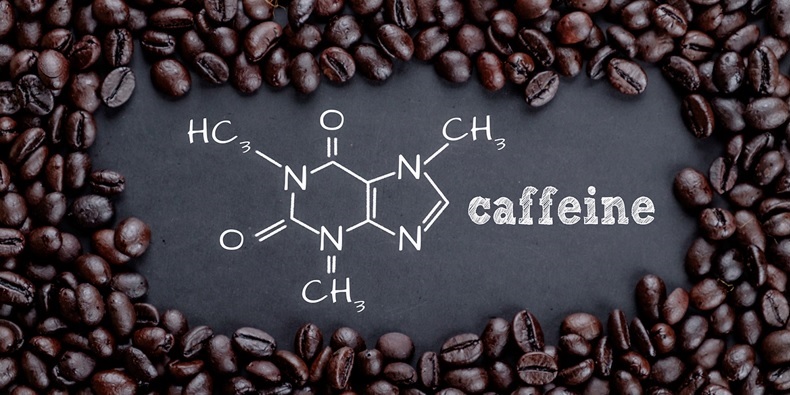Caffeine is a substance that is found in a large number of products and is part of the usual diet of athletes, in the form of coffee, energy drinks, gels, or dietary supplements. How much do you know about it?
Amount of caffeine in different products
| Product | Caffeine Amount (mg) | Volume or weight |
|---|---|---|
| Coffee | 40 – 180 | 150 mL |
| Tea | 25 – 50 | 150 mL |
| Cacao | 5 – 10 | 150 mL |
| Soft Drinks | 20 – 60 | 250 mL |
| Energy Drinks | 85 – 175 | 250 mL |
Since the beginning of humanity all cultures have consumed caffeine, and the health risk that this entails is minimal. From an ethical point of view, it is an absolutely legal substance.
Mechanism of action of caffeine
Our body has adenosine receptors, which, when captured, perform functions such as the control of sleep-wake cycles and suppression of nervous excitation, thus producing a sedative effect. When ingesting caffeine, it will compete with adenosine for these receptors, causing them to be occupied by caffeine instead of adenosine. This produces very noticeable changes, since caffeine will produce a stimulation of our central nervous system, producing the effects that we will mention next.
Effects of caffeine on our body
– Stimulates the central nervous system
– Increases the secretion of catecholamine: adrenaline and norepinephrine.
– Increases blood pressure and heart rate.
– Increases urine output (urine).
– Fatigue reduction.
– Decreases the sensation of perceived exertion.
– Increases fat oxidation.
– Increases sports performance.
– Increases mental activity.
The optimal quantity of caffeine: Posology

The optimal dose would be between 3.2 and 4.5 mg / bodyweight_kg. This improves performan
ce both in prolonged resistance exercises and those of greater intensity and short duration (up to 5 minutes).
Most studies indicate that caffeine should be administered at rest, one hour before starting the activity, since the plasma concentration peak would be reached in approximately one hour.
Tolerance to caffeine
As the vast majority knows, an abuse of the use of caffeine in our day to day can generate some tolerance to it, needing more and higher doses to achieve the desired effects. This can be explained because our body will create more adenosine receptors and, therefore, we will need a greater amount of caffeine to occupy all of those.
That is why we try to eliminate this tolerance by carrying out different strategies, in which this substance is stopped consuming for a while. This produces a reset on the adenosine receptors, so that our body can be highly sensible again to that substance.
The most general recommendations establish 2 to 3 week break for each 3 months of taking, although we can also use other highly recommended strategies. For example, consuming caffeine 2 to 4 days per week and matching the shots with the hardest workouts, in order to not take any shots for the rest of the week.
Another very important issue is the caffeine withdrawal syndrome: a radical cut in your intake can produce symptoms such as headache, malaise, low mood… So if we notice these symptoms when we stop drinking caffeine we should gradually reduce the shots and not cut their intake suddenly.
Effects of caffeine on performance

On long-term aerobic exercises
Most studies show improved performance, after the administration of caffeine, in resistance exercises where fatigue is delayed between 30 to 60 minutes. after the administration of a dose of 5 mg / kg of caffeine, scientists observed an increase of 13 minutes in exercise duration when performing at an 80% of VO2max.
About short-term anaerobic exercises
In 2002 a team of scientists studied 100 m freestyle swimmers and observed that caffeine intake improved times by about one second for those trained swimmers. The untrained individuals had no improvement. It has also been observed that caffeine improves maximum potency in the 6-second Wingate Test.
About strength

Muscles vary their fibrillar composition to meet the functional demands from their role in movements or in maintaining the posture. This is also reflected in a high heterogeneity in the topological distribution of the fibers in each muscle or muscle fascicle.
Interference of creatine and caffeine
All this debate on the interference of creatine and caffeine begins with a study conducted in 1996, in which it was concluded that the group that drank caffeine plus creatine did not improve performance, while the one who only took creatine managed to improve it.
Theories have been raising for many years trying to explain why this interference occurs:
Some said that since ATP is adenosine triphosphate and caffeine has an adenosine-like structure, it would block adenosine receptors and interference would occur. Others attribute it to both having opposite effects in terms of water regulation, since creatine tends to increase the amount of intramuscular water and caffeine tends to do the opposite. On the other hand, others argued that caffeine decreases muscle relaxation time (TRM), while creatine increases it. And finally, some attribute these interferences due to the gastrointestinal problems that these two substances can produce.
For this reason, nowadays we cannot assure that caffeine and creatine interfere. It is true that different studies that are currently being published show that this interaction does not occur. So, still a larger number of studies are needed to ensure that these two substances do not interact with each other.